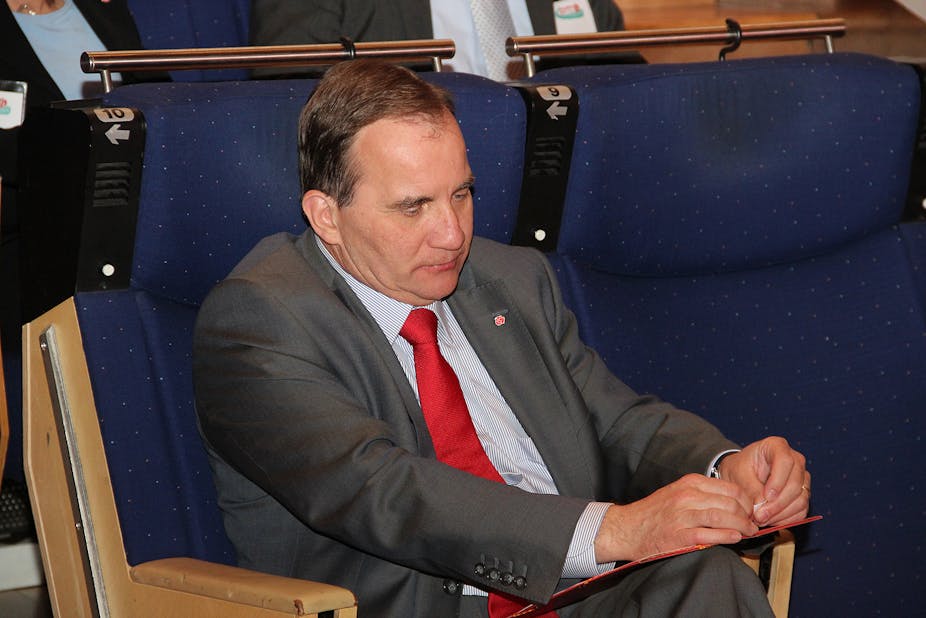Sweden’s Social Democratic Party has won the most votes, but it can hardly be seen as the winner in an election where it barely increased its vote share while the anti-immigration Sweden Democrats more than doubled its support. Stefan Löfven, the Social Democrat party leader, now faces the unenviable task of attempting to form a government with a rather weak electoral mandate.
The Social Democrats constitute a red-green bloc in parliament with the Greens and the Left Party. Together they received more votes in the election than the Alliance – a four party centre-right coalition led by The Moderates – but still fell short of the support necessary to form a legislative majority.
And despite the party’s high hopes, the inability of the Feminist Initiative to clear the 4% electoral threshold, having received just 3.1% of the vote, further complicates any attempt by Löfven to build a centre-left legislative coalition.
Löfven is to bypass formal collaboration with the Left Party and will not meet its request for a ban on private companies making a profit in the health and education sectors. This is widely understood as an overture to the smaller parties that are currently part of the Alliance, such as The Liberals or the Centre Party.
It appears that the Social Democrats will pursue a more centrist, centre-left government, expecting that the Left will still support its legislative proposals as the “lesser evil” than what would be put forward by the Alliance. There is, of course, some risk to this strategy.
Löfven will already need to propose a budget in mid-November so government formation and budgetary negotiations will go hand in hand. It could be strategic for the smaller parties of the Alliance to hold fast rather than co-operate with the Social Democrats on the budget. The Liberal Party has already indicated that the party will enter opposition rather than formally co-operate in a Löfven-led government and the Left Party is extremely displeased with the post-electoral strategy of the Social Democrats, so support from that corner is far from certain.
Rise of the new “right”
Another major change in the 2014 election has been the meteoric rise of the anti-immigration, nationalist Sweden Democrats. The party first entered the Riksdag in 2010 with 5.7% of the vote, received 9.7% in last spring’s European elections and more than doubled its support in this general election, garnering nearly 13% of the vote last Sunday to become Sweden’s third-largest party.
All seven of the country’s other parliamentary parties refuse to formally work with the Sweden Democrats because of the extreme stance the party takes on asylum and immigration. But this self-imposed prohibition on collaboration with the Sweden Democrats makes building a legislative coalition even more challenging for the Social Democrats.
The Sweden Democrats now control so many of the seats in parliament that are not occupied by representatives of the Alliance parties that they could prove a powerful voice in the chamber. The electoral success of the Sweden Democrats also calls into question how long the established parties will be able to marginalise the Sweden Democrats within the Riksdag.
The rise of the Sweden Democrats in the 2014 general election should be seen as particularly troubling for the Social Democrats. Outgoing prime minister, Fredrik Reinfeldt, was hoping to win a third term for his centre-right government – something never before seen in Sweden, a country politically dominated by the Social Democrats throughout much of the 20th century.
Standard understandings of electoral politics would predict an ebb in support for the Moderates after two elections with higher than normal support – and indeed this is what we saw in 2014. But, crucially, the Social Democrats only increased their vote share by half a point, receiving 31.2 per cent in 2014 compared to 30.7 per cent in 2010 – itself a historic low for the party, which routinely received over 40% of the vote in the past.
According to VALU’s exit poll, only 8% of the votes received by the Social Democrats this year came from people who voted for the Moderates in 2010. An equally high number of 2010 Moderate voters went to the Sweden Democrats in 2014, with former Moderate voters making up nearly 30% of Sweden Democrat support in 2014.
This suggests that the Social Democrats were unable to capture many of the Moderate voters that had grown tired of the party between 2010 and 2014. That in turn illustrates the struggle faced by the Social Democrats if they seek to appeal as a catch-all party in contemporary politics. All in all, it does not bode well for the party’s future electoral prospects.
New priorities?
Swedish politics has witnessed a decline in support for the formerly dominant mainstream centre-left and centre-right parties in favour of the Sweden Democrats and, to a lesser extent, the Feminist Initiative. These two very different parties share an emphasis on issues related to a cultural dimension of competition rather than classical left-against-right politics. The Social Democrats and Moderates are struggling to adapt and develop a better understanding of why voters are making these switches.
Citizens might be turning away as they see the traditional left- and right-wing parties converging on economic policy, for example. Whatever the reason, voters appear to be calling for their parliamentary parties to pay closer attention to social and cultural issues. The established parties want to fend off the rise of the anti-immigration right, but will need to do so while taking note of the messages being sent to them through the ballot box.

